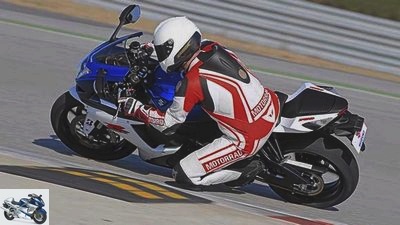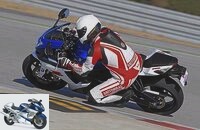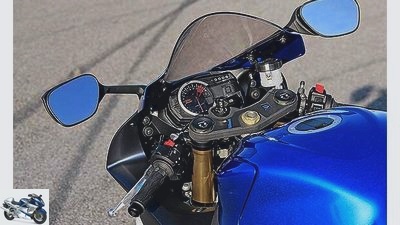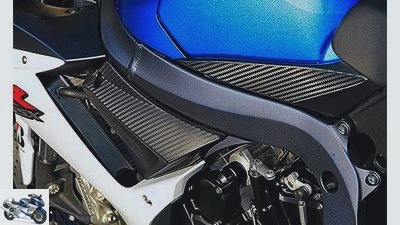Table of contents
- Driving report: Suzuki GSX-R 750 (with video) Slimmed down: Suzuki’s 750 super sports car
- Technical specifications

manufacturer
motorcycles
Driving report: Suzuki GSX R 750
Driving report: Suzuki GSX-R 750 (with video)
Slimmed down: Suzuki’s 750 super sports car
Suzuki has been building the GSX-R 750 since 1985. The latest motorcycle with this name will soon hit the streets, and it embodies a truly successful way of maintaining tradition.
Ralf Schneider
02/17/2011

Eight kilograms of weight loss compared to its predecessor should make the new GSX-R 750 even faster.
The 750 four-cylinder sounds simply sensational at fourteen-four. Especially on this short full-throttle piece with the slight right-hand curve that throws you in the twisted third gear in front of a slow 180-degree right loop. This is where the new one is served GSX-R 750 an unforgettable cocktail of experiences, mixed with a tingling roar of the engine and a lot of excitement before the braking point. More flavorful than the new 600, which is otherwise identical in many parts, but easier to enjoy than the force of a 1000.
Buy complete article

Driving report: Suzuki GSX-R 750 (with video)
Slimmed down: Suzuki’s 750 super sports car
4 pages) as PDF
€ 2.00
Buy now
Since MV Agusta drilled and lifted the F4 from 750 to 1000 cm³, Suzuki is the only motorcycle manufacturer in the world that still builds a 750 cc super sports car. Good this way. Displacement and performance between the two classes relevant for top-class sport, 600 and 1000 cm³, still make up the special charm of this motorcycle, especially since its weight and price were always closer to the 600 than to the 1000 and exactly the opposite in terms of driving dynamics was.
The best of both worlds for those who do not want to win a Superbike or Supersport championship title – a captivating idea that the middle of the three GSX-R sisters has won many fans, especially in Germany. Due to the price of the 2011 edition, which has increased by 650 euros, this collection of advantages has been postponed somewhat; the price of the 750 is now almost exactly between that of the 600 and 1000. If you also take into account that the large GSX-R is already in its third season and is being traded at greater discounts than the two smaller, new ones, the previous price advantage is additionally reduced. This does not harm the driving dynamics qualities of the 750s.
The Circuito Monteblanco near Seville has so many tight corners that the splendid withdrawal from medium revs is noticeable after just a few laps. Even if it is tormented from the middle of the curve with plenty of gas at low revs, the 750 will happily pick up speed, so quickly that it pushes the rear tire to the limit of grip. It remains to be tested how the engine, which has been refined in extensive detailed work, behaves in normal traffic and in even tighter curves. For now, it makes a pretty hefty impression.

If you duck down, you can enjoy proper wind protection on the GSX-R. A super sports car disguise doesn’t have to be able to do more.
However, despite the balancer shaft, the 750 runs a bit rougher than the 600, and it does not manage the load changes at the apex of the bend as smoothly as the smaller four-cylinder, nominally 25 hp weaker. When pulling up in the first bend after the long home straight, the 750 even pauses for a moment. Before that, the GSX-R reached almost 270 km / h according to the speedometer in almost turned out fifth gear, the braking phase lasts correspondingly long, and when the gas is opened again at about 60 in second, it looks for a moment as if they had changed Throttle valves stuck. Because the 750 series is faster at its peaks and has to be braked more often than with the 600 series in Almeria, some of the test machines showed fading in the afternoon, i.e. noticeable yielding of the pressure point and braking power. Once vented and provided with fresh pads, the brakes then did a constant job over a full twenty-minute section, even with deliberately late braking maneuvers during the very last lap of the day.
Although the brake discs of all test motorcycles had turned more or less dark blue from the sheer heat, this suggests that the fading was more caused by an inexactly vented hydraulic system than the brake calipers or the friction pairing. The chassis also aroused slight doubts about the preparation of the test motorcycles. Because of the stop-and-go nature of the routing, the set-up drivers had raised the rear of the 750 by six millimeters using washers in order to create particularly agile steering behavior, but he had to do so in the afternoon when the tester had learned the routing In the three left-right combinations when changing lean angles, be careful not to approach the second curve too closely. The GSX-R 750 proved to be more agile than necessary. You can’t blame her for that, unfortunately she was prevented from fully developing her chassis talents.

Depending on the amount of sunlight, the frame shimmers black or dark purple, an appealing play of colors.
It speaks for her that she didn’t seem nervous in long, faster bends, but kept the line clean without major corrections. Also, the driver did not feel involuntarily and uncomfortably pushed over the handlebars by the higher rear. Nevertheless, even with the standard setting, the 750 should waggle extremely nimble through tricky passages. The impressions of the 600er standing normally over the wheels make this prophecy more than likely. After all, both got the same chassis and the same tire dimensions, the overhangs on the fairing nose and the seat hump were shorter and in weight they only differ by three kilograms in favor of the 600s.
There is also consistency in the extensive equipment. In the display instrument with its numerous functions, the new, multi-stage switching signal is again noticeable, and if you can concentrate, you can also activate a lap timer for the racetrack. Variable footrests are now part of the good GSX-R tradition. The dark purple shimmering surface of the frame and swing arm at certain angles of incidence of light makes a noble impression. Even the imitation carbon used here and there fits so harmoniously into the overall view that you never really miss real carbon fiber laminate. And don’t forget: that fascinating fourteen-four-roar. Every now and then you just have to treat yourself to those goosebumps.
PER:
Weight eight kilograms lighter; engine powerful, easy to turn; Sitting position relaxed athletic; processing sophisticated, dignified
CONTRA:
engine Load change a little too hard, runs rougher than the 600; brake A tendency to fading cannot be completely ruled out
Technical specifications
engine
Water-cooled four-cylinder four-stroke in-line engine, a balancer shaft, two overhead, chain-driven camshafts, four valves per cylinder, bucket tappets, wet sump lubrication, injection, Ø 42 mm, regulated catalytic converter with secondary air system, 375 W alternator, 12 V / 8 Ah battery, mechanically operated multiple discs -Oil bath clutch (anti-hopping), six-speed gearbox, O-ring chain, secondary ratio 45:17. Bore x stroke 70.0 x 48.7 mm Displacement 750 cm³ Rated output 110.3 kW (150 PS) at 13200 / min Max. Torque 86 Nm at 11200 / min
landing gear
Bridge frame made of aluminum, upside-down fork, Ø 41 mm, adjustable spring base, rebound and compression damping, two-armed swing arm with upper struts made of aluminum, central spring strut with lever system, adjustable spring base, rebound and compression damping, double disc brake at the front, Ø 310 mm, four-piston fixed calipers, rear disc brake, Ø 220 mm, two-piston fixed calipers. Cast aluminum wheels 3.5 x 17; 5.5 x 17 tires 120/70 ZR 17; 180/55 ZR 17
Dimensions + weights
Wheelbase 1390 mm, steering head angle 66.3 degrees, caster 97 mm, spring travel f / r 120/130 mm, seat height 810 mm, empty weight 190 kg, tank capacity 17.0 liters. Two-year guarantee Colors black, blue / white Price 13140 euros Additional costs 190 euros
Related articles
-
Photos: Markus Jahn motorcycles Driving report Honda CBF 1000 Driving report Honda CBF 1000 The candidate Germany has been waiting for him. Honda’s new…
-
Driving report Aprilia Mana GT 850 ABS
Aprilia motorcycles Driving report Aprilia Mana GT 850 ABS Driving report Aprilia Mana GT 850 ABS (2009) Half-boarded GT version of the V2 machine The…
-
Driving report: Honda CBF 1000 F
Rudolph 10 pictures Rudolph 1/10 Even when the going is steep uphill, the CBF 1000 F pulls on without ceasing. Rudolph 2/10 Now adjustable: the spring…
-
Driving report Suzuki GSX-R 600 (2008)
Suzuki motorcycles Super athlete Driving report Suzuki GSX-R 600 (2008) Driving report Suzuki GSX-R 600 (2008) Gixxer with a new swing The new GSX-R 600…
-
BMW S 1000 XR in the driving report
markus-jahn.com 21 pictures markus-jahn.com 1/21 BMW S 1000 XR. markus-jahn.com 2/21 … it always goes down. markus-jahn.com 3/21 BMW S 1000 XR….
-
Driving report Ducati Streetfighter S
Ducati 7th pictures Ducati 1/7 Ducati Streetfighter / S Ducati 2/7 Ducati Streetfighter / S Ducati 3/7 Ducati Streetfighter / S Ducati 4/7 Ducati…
-
Driving report Supersport World Championship machines
Artist motorcycles Super athlete Driving report Supersport World Championship machines Driving report Supersport World Championship machines The World…
-
KTM RC 125 in the driving report
KTM 17th pictures BLACK&WHEEL! 1/17 KTM provides the Dukes with the RC series, also as 125, 200 and 390 and also produced in India. The premium in…
-
Driving report: Triumph Rocket III Roadster
triumph motorcycles Driving report: Triumph Rocket III Roadster Driving report Triumph Rocket III Roadster (2009) None is stronger, none accelerates…
-
Artist motorcycles Super athlete Driving report Ducati 999 Driving report Ducati 999 (2004) Facelift The Ducati 999 has so far not been spoiled by sales…